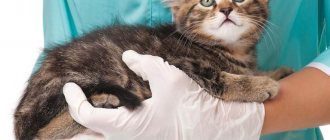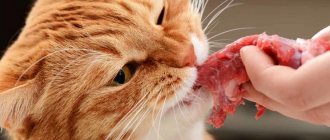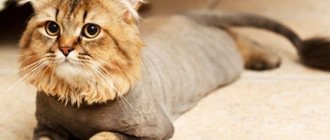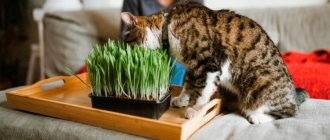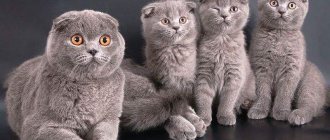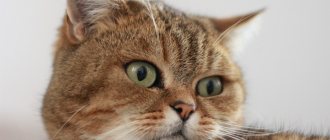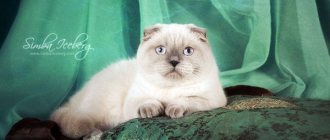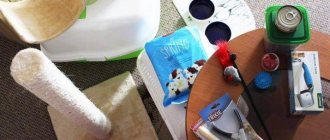After grooming, the Scottish cat needs to be washed again with shampoo. This will remove cut hairs and wash out the bottom layer of fur that may not have been completely cleaned during the first bath.
Grooming a cat is a rather labor-intensive and complex process, since most pets do not tolerate such procedures well. Therefore, unless absolutely necessary, you should not subject the animal to such a test. And if the owner is not confident in his skills, then it is better to seek help from professionals.
Do Scottish Fold cats need to be cut?
Grooming a Scottish cat is not the most popular procedure; most often the hair is shortened as needed, for example, before medical procedures or if the pet is very dirty. Some owners prefer to groom their cats before shows and for photo shoots.
Important! If a Scot is getting his hair cut for the first time, then it should be done by a specialist. Then the cat will receive minimal psychological stress, and the owner will become familiar with the procedure and will be able to repeat them on his own in the future.
Reasons for haircut
The most common reasons that prompt an owner to cut a Scottish cat's hair are:
- Formation of tangles and unkempt appearance of the coat. This applies to long-haired Highland Folds that are poorly groomed.
- Excessive and prolonged shedding - during this period, Scottish cats are cut to get rid of excessive amounts of hair on carpets and sofas.
- Skin diseases. More often they arise due to poor care of the Scots, but sometimes they also appear for reasons beyond the control of the owners.
- Formation of hairballs in the stomach (trichobezoars).
The thick undercoat forms a dense “felt” layer, does not allow air to pass through and creates comfortable conditions for the proliferation of skin parasites. Unlike tangles, which you can try to comb out, here cutting is the only rational solution.
Education and training
Fold cats are very smart and easy to train. Teaching your pet basic skills is not difficult.
It is advisable to accustom your cat to order and discipline from an early age. To accustom a kitten to the tray, it is enough to often play with it not far from the tray and, if necessary, immediately put it there.
Soon he will remember where to relieve himself.
Teach your fold cat to listen to its owner and understand the command “No!” You can use a regular baby rattle.
It is enough to simply rattle it loudly over his ears and loudly say “No!” when he does something forbidden (for example, tries to climb on the table or starts scratching the furniture).
Folds are very sensitive to loud sounds at an early age, so training using similar methods gives results. It is not recommended to physically punish a kitten, as in the future it may stop trusting its owner and be afraid of him.
For good behavior and obedience, the pet must be praised and rewarded with some kind of treat.
Scottish Folds very quickly get used to the house and the owner. Despite their independence, they still require at least a little attention.
If the owner is often not at home, the kitten may start meowing in the middle of the night, thereby attracting attention to itself.
To prevent this from happening, you need to devote at least 10-20 minutes of time to it before going to bed. They rarely spoil things and almost never jump on furniture and curtains.
If your pet is left alone in the apartment for a long time, it is enough to leave him a few toys, such as balls or a rubber mouse. In this case, the pet will not be bored for a long time, and will have something to do in the absence of the owner.
How to cut your hair at home
Tools and accessories
You can only trim a very calm cat at home, and if it is already accustomed to such a procedure. The easiest option is to trim the fur with a machine with one attachment. Every owner should have the simplest skills necessary for grooming a pet. In hot weather, a short hairstyle can save your long-haired pet from heatstroke.
You will find most of the cutting equipment at home. The procedure can be done on a table, covered with a sheet, or on an ironing board. In the latter case, the “stand” must be stable. Scissors - simple and thinning - will also come in handy. Hair clippers are also often found in homes. If not, you can purchase it at the store. It should be comfortable and have various attachments. You cannot do without it when performing the procedure. Also purchase three percent hydrogen peroxide and cotton wool. Your pet should also have a comb-comb.
A minimum of two people will be needed to perform the procedure. It is better if the helpers know how to handle cats.
How to care
A pet's appearance is directly related to its physical and psychological well-being. Since the cat and its owner are still separated by a language barrier, the best solution is preventive care, which consists of regular sanitary and hygienic measures.
Pet hygiene
Regardless of the nature and age of purrs, they always remain small children in need of care and human intervention in their cat life. With the right approach, flexible Scots quickly adapt and get used to the necessary manipulations, withstanding the systematic invasion of personal space with dignity. Despite the fact that representatives of the fold-eared brethren are kept exclusively at home, they must be washed every few months.
In this case, water procedures must be carried out according to the following rules:
- the animal is placed in a shallow container in the form of a basin, filled to half;
- the water temperature should be between 33–35 °C;
- the use of special shampoo or hypoallergenic products is allowed;
- to improve the quality of bathing, use only pet brushes intended for this purpose;
- dry the cat with a towel.
It is unacceptable to use improvised means in the form of laundry soap or human combs, as they can cause allergies and skin damage. It is also strictly forbidden to try to remove moisture with a hairdryer - this, at a minimum, will cause stress for the pet. Folding, as the main characteristic of the breed, obliges owners to carefully care for this part of the animal’s body. Initially, kittens are born straight-eared, but as they grow older they begin to meet the standards more and more. A deformed ear is a convenient place for the accumulation of dirt and the development of bacteria - they become a source of otitis and dermatitis. That is why it is necessary to carry out regular inspections at intervals of at least two weeks.
To clean ears, you can purchase lotions in veterinary pharmacies or pet stores that remove dirt well and have an antiseptic and anti-inflammatory effect. Wipe the ears with cotton pads soaked in a special preparation. Another mandatory procedure is nail trimming. This must be done using special nail clippers. The procedure requires perseverance and patience. By carefully pressing on the pet's paw in the phalanx area and exposing the claw, it is cut off by no more than 2 mm. If you overdo it, you can touch an area with soft tissues and capillaries, which will cause pain to the animal and can provoke an infectious infection.
Grooming
Scottish cats are famous for their thick, plush fur. This feature makes them extremely pleasant to the touch, but the price for such pleasure is regular combing. Often this procedure becomes pleasant for the pets themselves, which greatly simplifies its implementation. Representatives of the breed with outstanding long hair should be brushed daily, but for short-haired animals once a week is enough.
The structure and high density of the hair can cause some trouble when the purr begins to shed. Often during such periods, the living space is practically covered with a carpet of cat underfur. Using a furminator will help prevent a hairy disaster. This device removes a significant part of the undercoat, as well as dead guard hairs, thus significantly reducing the appearance of shedding.
What harm can a haircut cause?
The negative consequences of grooming in Scottish cats include both physiological and psychological factors:
- If there are other cats in the house, the short-haired Scottish Fold will most likely lose authority in the family hierarchy of four-legged pets. He will have to re-prove his right to a “place in the sun.”
- It has been noticed that after a haircut, which is a serious psychological stress, pampered lop-eared Scots very slowly return to normal.
- Damage to the whiskers during the cutting process. Sensitive hairs grow throughout the cat's body and help her navigate in space. Therefore, after the procedure, the animal may sway slightly when moving, but this quickly passes.
- Skin deprived of hair becomes chapped, peels and dries out. Additional care will be required to keep your Scots skin healthy until the new coat begins to protect it from the elements.
- It will take time for the fur to recover after shearing. The fact is that under natural conditions, hair does not change simultaneously, but is renewed gradually. Mechanical hair removal disrupts this process. Therefore, the new coat will be slightly worse than the previous one.
Most often, Scottish cats are cut on the recommendation of a veterinarian.
What to pay attention to
It is worth carefully monitoring not only the diet, but also the number of servings, since feeding Scottish Straight cats requires a clear dosage. This is due to the fact that this breed is prone to obesity and a Scottish cat cannot always control its appetite, when it is not really full, and when it has overeaten. However, if a Scottish cat leaves food on the plate, you should not immediately contact a veterinarian, because you can adjust the portion size based on the mood and activity of the Scottish cat.
The Scottish Straight kitten should be fed in such a way that 40% of all food is protein.
Up to a year, it is recommended to structure the diet in such a way that it is divided into three to four meals, and for adult cats, 2 feedings during the day will be optimal. A prerequisite must be the availability of clean, boiled water.
Types of haircuts
There are different ways to cut a Scottish cat's hair. However, two models have already become traditional for all cats:
- Haircut “like a lion” - the head and mane to the shoulder blades, paws and the tassel at the tip of the tail remain untouched.
- “Puss in Boots” haircut – from the neck the body is machined, at the end of the legs neat boots of arbitrary height are made and a tassel is always left on the tail.
- “Like a dinosaur” - the head and paws of a Scottish cat are cut “like a lion”, but a jagged ridge of wool is formed along the spine.
- Cat in a skirt - haircut for girls. A fluffy hem is left on the body just below the line where the ribs end, and the rest of the hair is shaved.
This is interesting! Recently, a new fashion trend has emerged - applying colored patterns to wool. You need to use only high-quality paints that are safe for your pet’s health.
What to do if your cat is vomiting hair
It’s not for nothing that we touched on this unfortunate and frequently asked question to veterinarians. If a cat vomits hair, then a large amount of hair has accumulated in its stomach. And the reason for this is the owner’s reluctance to comb his pet.
Kitty cleanses her stomach of accumulated fur
It's not too late to fix everything and help your pet get back to normal:
- Brush your long-haired pet several times a day every day. As for their brothers with short fur coats, here you can get by once every 2-3 days.
- Bathe your cat during shedding 1-2 times every 2 weeks. If your furbaby loves to take baths, you can do this more often.
- Feed your pet green grass. This will help him quickly clear his stomach of unnecessary contents.
Cats enjoy eating fresh greens
- Buy specialized food that helps to quickly clear the gastrointestinal tract of accumulated foreign matter. Today there are many manufacturers of such food.
- Veterinary pharmacies sell a special paste for removing hair from the stomach. The product is very effective and quickly removes unnecessary contents from the digestive tract. You need to use it for at least a week.
Paste for removing hair from the stomach
- If hair falls out in large quantities all year round, perhaps the problem lies in diseases or some other malfunction in the body. Therefore, it is more advisable to show the animal to a veterinarian and undergo an examination.
- Monitor the animal's diet. Buy him vitamin food and do not give him food from the table. As a rule, the latter is the main reason for the cat’s poor health and intense hair loss.
- To cleanse the intestines and stomach, it is often recommended to add a few drops of flaxseed oil, a little fish oil or oats to your pet's food. Be sure to consult your veterinarian before use.
Brushing a British cat
Combing is one of the important procedures for caring for cats. Thanks to this manipulation, you can remove not only dead hair, but also get rid of parasites, dirt, tangles, etc. In addition, combing promotes fur renewal and also prevents the ingestion of a large number of hairs. Therefore, try to regularly resort to this procedure. If your cat has long hair, brush him daily during the shedding period. If the coat is short, 1-2 times every 2-3 days is enough.
Why groom cats?
Typically, cats are clipped for two reasons. The first is to take care of the pet’s health, and the second is to add attractiveness. Regarding health status, there are medical indications for grooming:
- skin diseases;
- infestation with ticks and fleas;
- hyperplasia.
In all these cases, the skin should be treated with medications and haircuts cannot be avoided. Also, with age, it is difficult for elderly pets to keep their fur coat in good condition, so by trimming the fur, the owner makes it easier for himself to care for his pet.
There are also cases when an animal was picked up on the street, and the cat looks unsightly: tangled fur, pellets and “icicles.” The only way to help your pet and bring it back to normal is to trim its fur. But it will be difficult to manage on your own.
Scissors should not be allowed in as they can damage the skin. It is also unlikely that you will be able to comb matted fur. Bathing is problematic, since tangles take a long time to dry and can lead to inflammation. The only way out is to shave your pet and continue to provide careful care. You should shave with a clipper carefully, holding the skin so as not to injure the little one.
Ear and dental care
The British Straight-eared kitten also requires careful ear hygiene and regular dental care. Such procedures involve cleaning the ears using a special cotton swab, which is moistened in a liquid purchased at a veterinary clinic.
Considering the peculiarity of the structure of the ears, a scrupulous attitude to their hygiene is required, which consists of carefully turning out the ear cartilage and cleaning the ear canal
Examination and cleaning of teeth should also become a mandatory procedure, since identifying or forming plaque on teeth at an early age will allow them to be quickly eliminated almost painlessly. Your cat's teeth should be white and her gums an even pink color. Inflammation or swelling of any type is not allowed.
By following these basic rules on how to care for a Scottish cat, you can provide your pet with a well-groomed appearance and good health.
How often can you groom an animal?
The regularity of haircuts depends on 2 factors: the cat’s reaction and possible consequences for its health. If the first haircut provoked long-term stress or lowered the status of the animal among other four-legged animals, then in the future it is worth abandoning such procedures.
You also need to pay attention to how the haircut affected the structure and color of the coat.
Before grooming your pet, it is advisable to seek advice from a professional groomer or veterinarian.
Important! Shorthaired Scottish Fold Fold cats are groomed no more than once a year. Longhaired Highlands will take even longer to fully recover from the first treatment.
Appearance of the Scottish Straight
Scottish Straights can easily be confused with the British, although representatives of these two breeds have a minimum of common genes. Scottish Straight cats are much smaller than their competitors from Albion, although they have a longer body. The weight of an average straight is 3-3.5 kg. Modern breeders are still wondering what kind of offspring they will get after mating a fold and a straight, since initially all kittens are born with ordinary ears, which change their position only at the end of the first month of life.
Head
Whiskered Scottish
According to the WCF standard, Scottish Straights must have a rounded skull. Representatives of this breed have convex foreheads and cheeks. In cats, the area of the cheekbones and cheeks is noticeably more rounded than in cats. The chin of the Scots is firm, rounded, but does not protrude forward. The whisker pads are distinguished by their characteristic “swelling” and have the shape of a regular oval.
Nose
Wide and short, with a slight arch of the back and a pronounced base, practically without a stop.
Eyes
Large and round, widely spaced. The gaze is open, inquisitively focused. Eye color depends on the coat color of the animal.
Ears
Erect, small, with a wide base. The tips of the ears are rounded and point forward. The outer part of the ear is covered with thick, close-fitting hair. The inner part is decorated with lush and stiff hair brushes extending beyond the edge of the ear.
Neck
The Scottish Straight cat has a muscular and short neck.
Scottish Straight muzzle
Frame
Moderately long, muscular and wide, tending to the rectangular type. The silhouette line is soft and rounded.
Limbs
Proportional to the body, that is, moderately long and strong, with developed muscles. The paws are oval, the toes are tightly clenched.
Tail
Medium or long, mobile, reaching to the middle of the shoulder blades.
Wool
Scottish Straight tabby color
Short or semi-long (in Highland individuals). Double, plush type, with well-developed undercoat. It does not adhere to the body, but covers it tightly. The texture of the coat may vary slightly depending on the season, as well as the type of color of the animal.
Color
The standard allows all types of colors found among representatives of this breed. The most typical color options for Scottish Straight cats are solid, bicolor, point, tabby, particolor, chinchilla, ticked, van and shedded.
Defects in appearance and disqualifying defects
Individuals with semi-erect or too wide ears with a British set are considered not the most successful representatives of their breed. The flat forehead, pronounced stop, long legs and small eyes of the Scottish Straight are also not decorative. Animals with an insufficiently long, inactive and kinked tail, cryptorchidism and everted toes are subject to unconditional disqualification. Weak and sick cats are also not allowed to participate in exhibition events.
Kittens from a Scottish Fold cat, with an average of five straight-eared and one fold-eared
Why do you need a cat grooming?
The main purpose of grooming is to take care of the condition of the cat's coat. It is in the nature of the cat breed to take care of its fur. But often the efforts of pets alone are not enough, this is especially true for cats whose fur exceeds 3 cm. Those with long coats are recommended additional care, which includes daily combing, removing tangles, and cutting off excess hair.
There are two types of zoo clipping:
- Hygienic.
- Model (exhibition).
What owners should know
Model or hygienic grooming of cats is a safe and useful procedure, but there are cautions and contraindications for its implementation. It is best for owners to be aware of the possible adverse effects before trimming their pet. Many owners follow fashion trends without thinking about how their four-legged friend will react to all sorts of innovations.
- Visiting a grooming salon and contact with strangers is a huge stress for a cat. If there is no urgent need due to current molting, urgent preparation for an exhibition, the presence of a large number of tangles, or treatment of skin pathologies, then it is better to refrain from testing the pet’s nerves. Depending on the animal's temperament, groomers may use a partner to restrain the animal or administer sedation.
- There is no need to overestimate your abilities and try to remove fur from the skin of your furry four-legged friend yourself. It must be borne in mind that household scissors and clippers for cutting human hair are not suitable for such purposes. In any case, this cannot be done without outside help due to the fact that most animals are reluctant to allow their fur to be manipulated. The most harmless thing that can happen if domestic cats are groomed in an artisanal way is a spoiled appearance. But the worst thing is that you can injure the animal or get severe scratches from it.
- If your four-legged pet is not a sociable member of the cat family, so as not to have to use anesthesia, it is better to trim the cat at home using the service of a groomer. In a home environment, the cat feels in its territory and its behavior will be calmer.
- Long-haired cats should be groomed 2 or 3 times a year. The frequency of hairdressing procedures depends on the initial length, intensity of hair growth, and the health status of the pet.
- A few days before the hairdressing procedures, the cat will need to shorten its claws to prevent injury to the master, his assistants and the animal itself.
- It is strictly forbidden to cut the hair on the cat's head, shorten the mustache, eyebrows, or hairs in the ears. The tail must also be treated with extreme care; long hairs can be cut off from this area, but completely shaving off the fur is not recommended.
- It is necessary to take into account the fact that in some cats, after hairdressing manipulations, the fur changes its structure, the hairs become thinner or thicker or change color.
- From practice, there are cases when the fur of cats grows back to its original length over a long period of time or completely stops growing.
This is interesting: Where can you go without a visa?
Why do you need to groom your pets?
There are many situations in which grooming cats is acceptable, if not vital. And we’re not just talking about going to a felinological competition. Very often, veterinarians advise resorting to grooming when they notice a problem with the animal’s fur or skin.
In this regard, all types of haircuts for cats can be divided into two categories:
- Model.
- Hygienic.
Model grooming is performed mainly for exhibitions and is a real work of art.
A completely different matter is cutting the fur, which is necessary to maintain the health of the pet. Hygienic cat grooming has a more familiar look and is easy to perform:
- Most often, it is done to avoid matting of long hair or to remove formed tangles that cause pain to the cat.
- Cats actively lick themselves and can either injure themselves trying to gnaw out the mat, or eat a lot of hair, which rolls into lumps in the stomach and can cause intestinal obstruction.
- The veterinarian may prescribe a haircut in case of skin diseases or parasites.
- Some animals have a problem such as feces sticking to the long hair near the hind legs and tail. In this case, you don’t have to cut the whole animal, but just shorten the “pants” a little.
- Many cats with long or semi-long hair undergo grooming in the summer heat to protect them from overheating. This is especially necessary for Siberian cats, Persian cats, Norwegian forest cats and others accustomed to colder climates.
- It also happens that an old or sick animal cannot care for its fur on its own. In this case, a haircut helps him stay clean and look decent.
Model haircut "Dragon"
Model cat grooming can be done not only for a trip to an exhibition. Many owners regularly visit the salon to give their pet an original look. Each hairstyle is individual. And yet, there are several of the most popular varieties, on the basis of which groomers create their exclusive works of hairdressing art.
- "French Lion" For this hairstyle, the back, top of the paws and base of the tail are completely trimmed. The head and neck fur remain intact, giving the impression of a luxurious mane. The tip of the tail is not cut either. A specialist can give it the shape of a lion tassel, a pompom, a stepped herringbone or a neat whisk. Sometimes the fur is shortened just a little, resulting in a fluffy squirrel tail. The length of the “socks” and “gloves” on the paws can also vary. Thus, a unique image of the animal is created.
- "Puma." This haircut is done in almost the same way as the “Lion” option, but in addition the fluffy shirtfront on the chest is preserved.
- For the “Dragon” model, the sides and belly are cut smooth, while the hair along the ridge and tail remains untouched. It is only given the shape of a carved comb with sharp teeth.
- “Puss in Boots” fully corresponds to its name: the fur on the animal’s back is shortened, and the upper part of its paws is cut off to make neat boots.
There are also more intricate haircuts - such as “Modern”, “Continental”, “Harlequin”. All of them are performed only by specialists.
Model haircut "Puss in Boots"
The question of whether to contact a specialized office or trim the pet’s fur themselves arises among owners very often. There are quite a lot of arguments in favor of both options. Grooming cats at home is much cheaper, and many mustachioed purrs perceive trips to the salon as very stressful.
The difficulty is that not all animals tolerate grooming calmly. Some people so actively resist attempts to cut their hair that they have to be sedated. Most often, mild muscle relaxants are used in this capacity: these medications do not completely immobilize the cat, but reduce activity and make all its reactions more inhibited. Only a professional can choose the right medicine, give the correct injection and monitor the condition of the four-legged patient.
Even choosing a shampoo for bathing before a haircut sometimes turns into a difficult task. An incorrectly selected grooming product can damage the coat, cause allergies or skin irritation, and in the worst case scenario, even cause the animal to go bald.
Additionally, cat grooming varies greatly in difficulty. Hygienic or the simplest of model haircuts, such as “lion”, “puma” or “puss in boots”, can be easily done at home. Others, more complex ones, can only be done by a specialist. Thus, it is often much easier to pay for a trip to a clinic or salon. Usually a groomer gives a cat a haircut in an equipped office, however, a home call is quite possible.
Animal clipper
If you still decide not to go to the salon, then keep in mind: grooming cats is not the easiest task. You will need a lot of patience and some tools:
- Hair clipper.
- The attachments for it are at least 3 mm long (it is best to use veterinary attachments No. 3 for these purposes).
- Comb-comb.
- Regular or hairdressing scissors (if you want a “designer” hairstyle, you can take both regular and filer scissors).
- A high table or ironing board at which you can work comfortably.
- Just in case, prepare hydrogen peroxide and cotton wool.
And, of course, you need to take into account that for such a procedure you will need an assistant, or better yet two. After all, most animals perceive attempts to cut their hair very aggressively, and someone will have to hold the wayward cat so that she does not injure her “hairdresser.”
Place your pet on the tabletop, holding him by the front and back legs so that he cannot twitch. Carefully trim the fur first on the back, then on the belly, paws and tail. If necessary, trim any stray hairs.
After completing the procedure, be sure to bathe the animal to wash off any remaining hair on its skin.
Professional groomer kit
If you have dreamed of getting yourself a lion since childhood, but there was no opportunity, then this video will show you how to transform...
Technique of the procedure
Before grooming Scottish Folds, it is recommended to trim their nails. You can also use thick wristbands to protect your wrists from scratches.
The procedure is carried out in several stages:
- Apply a degreasing composition to dry wool and rub it well along the entire length of the hair. In longhaired Scots, special attention is paid to the tail, hind legs and collar area. To the rest of the body (including the head), the drug is usually applied without much effort.
- After the period of time specified by the manufacturer, the product is washed off with water.
- Apply the main shampoo, rub it with your hand until foam forms and after 2-3 minutes rinse thoroughly. The procedure can be repeated several times (depending on the degree of contamination of the wool).
- The final stage is treatment with conditioner, which gives the wool shine, silkiness and covers it with a protective layer.
- After bathing, the Scottish cat is wrapped in a towel and the coat is dried.
- The haircut is performed using a special electric clipper, but in the groin area and under the tail, the hair is carefully removed with ordinary scissors.
- Scissors are also used to form curly elements of the hairstyle and trim.
After grooming, the Scottish cat needs to be washed again with shampoo. This will remove cut hairs and wash out the bottom layer of fur that may not have been completely cleaned during the first bath.
Grooming a cat is a rather labor-intensive and complex process, since most pets do not tolerate such procedures well. Therefore, unless absolutely necessary, you should not subject the animal to such a test. And if the owner is not confident in his skills, then it is better to seek help from professionals.
What should you know about grooming?
Grooming cats is a complex process with many nuances.
- Under no circumstances should you cut your head, ears or whiskers: there is a risk of damaging the whiskers.
- Don't cut your tail bald: most cats try to chew it and cause serious wounds to themselves. Keep hair on at least one third of the tail.
- The same applies to the paws: it is imperative to leave “toes” in the area of the toes and the lower joint of the paw. But their length may vary.
- After shortening, the color of the coat may change dramatically.
- It is better not to cut animals with color point or tipping color at all: after this, the coat will sharply darken.
- The ideal length of shortened wool is 3 mm. It feels like velor fabric or plush to the touch, does not prick and does not cause discomfort to the animal. If you cut with a 1 mm nozzle, then the first week the hairs will be very stiff and only then will they acquire their usual softness.
- Don't cut your cat's hair. The skin of these animals is very delicate and can easily burn even in not too hot sun. In addition, the fur reliably protects them during play, and a hairless cat can seriously be scratched simply by scratching.
- Tangles can only be removed using a machine. Scissors should be used only as a last resort and with extreme caution. To do this, a fine comb is threaded under the mat, and the wool is carefully cut over it.
- If you are preparing for an exhibition, take care to do your pet's hair no later than six months in advance. Then it can be corrected a little.
